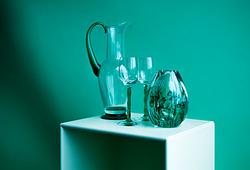Fernand Léger
"Composition à L'oiseau, esquisse"
Signed F. Leger and dated -47. Canvas 33 x 46 cm.
Provenance
Earlier in the collection of Consul Carl Eric Schlyter, Stocksund, Sweden.
The collection of Bo and Margareta Lindh, Stockholm, Sweden.
Literature
Georges Bauquier, "Fernand Léger - Catalogue raisonné, 1944 - 1948", 2000, listed as no. 1271, illustrated full page in colour p. 183.
More information
In his entire artistic production, Fernand Léger moved between the abstract and the figurative. In his greatest works, he achieved a synthesis between these two opposites, which the painting in the Lindh Collection, “Composition à Lóiseau” well illustrates.
The painting was made in 1947 when Léger had returned to Paris after spending five years in exile in America during the Second World War. America made a strong impression on him; not only New York City, pulsating and lively with all its advertising and neon signs, but also the countryside – especially the little village of Rouses Point on the Canadian border, which he often visited. Nevertheless, his return to France renewed his love for his homeland and filled him with an enthusiastic belief in the future. In 1946 he described his feelings in an article in Arts de France: “I want to express what I felt in returning to France, the joy I have had in rediscovering my country…I assure you that people have made great progress in France. I assure you that a magnificent evolution has come about…I have faith in France.”
Through his art, Léger wanted to contribute to the rebuilding of his country and was very productive in the years after the war. During this period, alongside his painting, he worked with a number of different techniques and materials including ceramics, sculpture, glass and mural painting. He also opened his own art school, Atelier Fernand Léger, which many young American artists were drawn to because of Léger’s reputation in the US. His students included the artists Kenneth Nolan, Sam Francis and Richard Stankiewicz.
Despite his many other projects, Léger continued intensively with painting, which in this period, took on a freer and more organic expression. The geometrical forms receded in favour of more representative elements, often inspired by nature and its surroundings. In 1950 he explained his art in the following terms:
The plastic life, the picture, is made up of harmonious relationships among volumes, lines and colours. These are the three forces that must govern works of art. If, in organizing these three elements harmoniously, one finds that objects, elements of reality, can enter into the composition, it may be better and may give the work more richness.
Léger perceived that during this post-war period, in contrast to that of post World War I, human beings were losing contact with nature and becoming prisoners of the machine. This insight led him, in the late 40s, to abandon the modern city in favour of the countryside, a move reflected in the piece on auction, “Composition à L’oiseau”. The painting is filled with light and vital colours that are intensified against a cool, neutral background. The artist has combined pure abstract floating shapes with the tree’s extended boughs which dissolves the boundary between reality and fantasy. Léger often made several versions of his compositions, which gave him the possibility to investigate, through small variations, the relationship between colour and form. The motif of “Composition à L’oiseau” recurs in two paintings, both from 1947: “Composition sur fond Jaune” and the larger piece, “Composition aux deaux Oiseaux”. The latter is part of the Johannesburg Art Gallery’s collection and contains two flying doves -- the symbol of peace.
“Composition à L’oiseau” is an exquisite example of the closeness and love of nature that suffused Fernand Léger’s art at the end of the 1940s and shows how the artist was able to harmonize colour, form and line into a lively, organic whole.


























